Prevention and Management of Apple Maggot in Commercial Apple Orchards in British Columbia
Apple maggot is a serious pest of apple that is not yet established in the main apple producing areas of British Columbia. This page provides information on prevention, identification and management of apple maggot in commercial apple orchards.
Apple maggot was first detected in the Fraser Valley of British Columbia in 2006. As of 2013 apple maggot had yet to be detected in the fruit production areas of Interior B.C. including the Okanagan, Similkameen and Creston valleys.
Effective protection of commercial orchards from apple maggot (Rhagoletis pomonella) infestations requires an understanding of the pest’s life cycle, recognition of the pest and its damage, an awareness of its presence and abundance, and area-wide cooperation of all host tree owners to apply control products in a timely and proper fashion.
Hosts
Primary hosts of apple maggot are apple, crabapple and hawthorn. However, research2 from Washington State found apple maggot also attacks Asian and common pear, European plum, bitter cherry (Prunus emarginata), and spreading cotoneaster (Cotoneaster divaricatus). Sour and sweet cherry were not found to be hosts in Washington State2, but were in Wisconsin3 and Utah4.
Identification
Adult: Adults are about 5 mm long, slightly smaller than a house fly, black body with yellowish head and legs, and green eyes. Wings have black bands, which are used to identify this pest from related fruit flies (Figs. 1 & 3).
Larva: White, legless, maggot-like with no distinct head, about 6.5-8 mm long when mature (Fig. 2).
Pupa: About 5 mm long, gold to brown colour, oval shape.
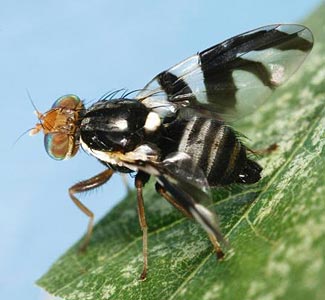 |
Fig 1. Apple maggot adult. Photo credit Joseph Berger, Bugwood.org |
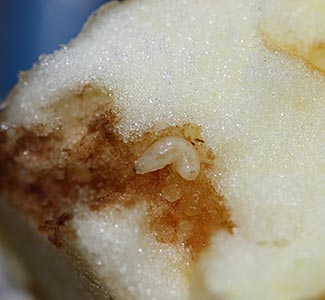 |
Fig 2. Apple maggot larva |
|
Fig. 3. Wing patterns of other flies related to apple maggot. Photo Credits: Naomi DeLury, Howard Thistlewood , Michael Weis and Jacqueline Sztepanacz, Agriculture & Agri-Food Canada, Pacific Agri-Food Research Centre, Summerland. |
|
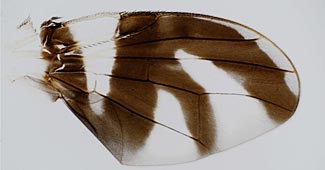 |
Fig. 3a. Apple maggot / Snowberry fruit fly wing |
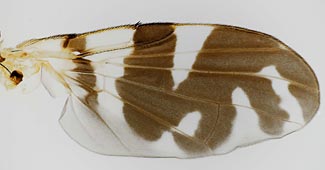 |
Fig. 3b. Black cherry fruit fly wing |
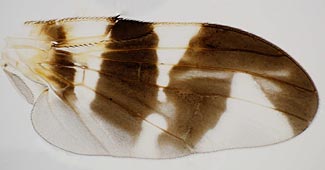 |
Fig. 3c. Walnut husk fly wing |
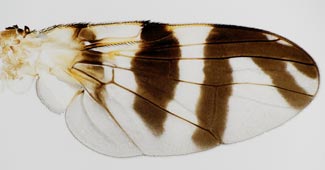 |
Fig. 3d. Western cherry fruit fly wing |
Life Cycle
This description of the apple maggot life cycle is based on information from Washington State University1 which should be very similar to that of apple maggot populations in the Lower Mainland. The pest overwinters as pupae under host trees. Adult flies begin to emerge in late June to early July and continue to emerge until early October. A small percentage of flies may not emerge for 2-3 years. Adults require 7-10 days to feed (aphid honeydew, bird droppings, other plant/insect exudates) and become sexually mature in order to mate and lay eggs. Females are attracted to ripening fruit to lay eggs and will move between hosts as the fruit ripens. This also applies to apple varieties that ripen at different times. Each female can lay a total of up to 500 eggs over its life time of 2-4 weeks. Eggs are laid singly just under the skin and hatch in 3-7 days. The larvae (maggots) burrow through the fruit before maturing in 13-50 days, depending on temperature. Mature larvae leave the fruit, usually after it has dropped to the ground, and burrow into the soil to overwinter. Any larvae in unharvested fruit in the fall are not likely to survive the winter.
Damage
Small dimples and depressions will appear where females insert their eggs under the skin of the fruit (Fig. 4). Apples infested early in the season will appear bumpy as they mature. Larval feeding damage appears as distinctive brown tunnels meandering through the flesh of the fruit (Figs. 5-7). Heavily infested fruit can become mushy and prematurely drop. In storage, even low levels of infestation can result in rotted fruit.
 |
Fig. 4. Apple maggot stings (egg laying punctures) and dimpling on fruit |
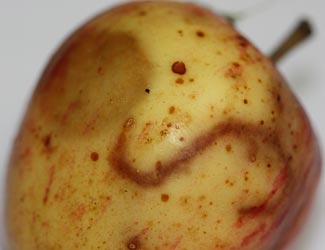 |
Fig. 5. Apple maggot external tunnelling damage |
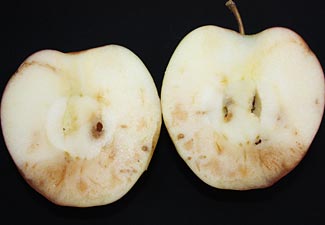 |
Fig. 6. Internal feeding damage by young apple maggot larvae. |
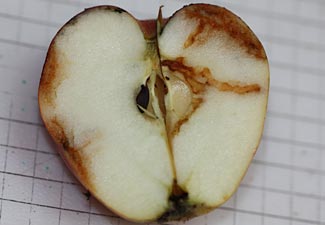 |
Fig. 7. Internal feeding damage by mature apple maggot larvae. |
The injury can be confused with that of codling moth (Cydia pomonella). Codling moth larvae create one or two tunnels through the flesh to the core where they feed on the seeds and inner fruit tissue; fecal pellets are present (Figs. 9 & 10). Codling moth larvae have distinctive brown to dark brown heads and six legs; apple maggots have no head capsule or legs, and have a wedge-shaped body with two small black hooks extending from the pointed ‘head’ end when feeding. Codling moth larvae grow to about 20mm, twice the size of apple maggot larvae.
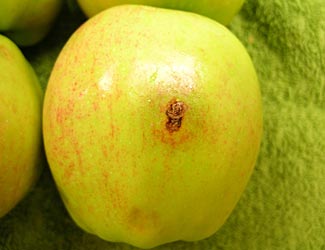 |
Fig. 8. Codling moth sting |
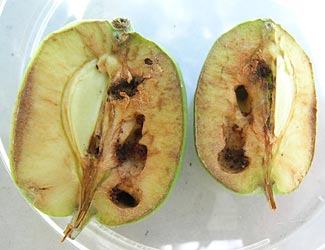 |
Fig. 9. Codling moth internal feeding damage |
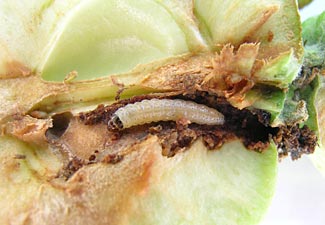 |
Fig. 10. Codling moth larva and internal feeding damage |
Monitoring
Monitoring adult apple maggots (Fig. 1) involves setting out ammonium carbonate-baited yellow sticky panels or sticky plastic red spheres (Fig 11) in host trees before mid-June*. Ammonium carbonate (AC) is available from most pharmacies. Place about 5 mL (1 tsp) of the AC bait in a small container (pill vial), and puncture the lid to allow ammonium vapour to escape. Pre-loaded lures are available from pest management suppliers. Follow the manufacturer’s recommendations on lure placement and maintenance.
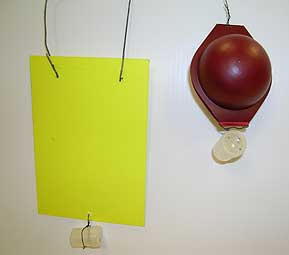 |
Fig. 11 Apple maggot traps baited with ammonium carbonate. |
The red plastic spheres (Fig. 11) are specific for apple maggot whereas the yellow panels will attract flies with wing patterns that resemble apple maggot (Fig. 3). The snowberry maggot wing pattern is identical to that of apple maggot, so red spheres are recommended where snowberry shrubs are present. Red spheres are more attractive to sexually mature flies seeking ripening fruit whereas yellow panels are attractive to immature flies seeking leaves in search of food.
To monitor for nearby apple maggot infestions that pose a high risk to your orchard, place traps in host trees within 0.5 km of the orchard. To monitor for apple maggot entering your orchard, place traps at intervals of 45 m along the orchard margins. Place traps further inside the orchard to confirm if infestations are already present. Set the traps in the outer 1/3 of the tree canopy, and remove all foliage within 30-45 cm to increase trap exposure. Place the traps 2-3 rows inside any border adjacent to dusty roads. Check the traps every 2-3 days and carefully remove any suspicious specimens and place on a piece of cardboard or stiff paper for confirming species identification. Citrus oil-based liquids and a fine brush can be used to gently remove flies from sticky traps. Refresh the sticky coating once it begins to lose its stickiness, about every 1-2 weeks.
Growers in the Lower Mainland, Vancouver Island, and Prince George areas (currently only known infested regions in B.C.) can submit specimens to the Plant Health Lab in Abbotsford and for a nominal fee have the identification confirmed. Growers in the non-infested B.C. Interior can also submit specimens to the Plant Health Lab free of charge or to the Ministry of Agriculture office in Kelowna, or to any Canadian Food Inspection Agency office.
* Trap and lure suppliers:
Yellow panels, red spheres, and lures can be purchased from:
Control Recommendations for Apple Maggot
Chemical Control
Apply one of the products listed in Table 1 within 7 days of first fly capture and repeat at intervals as recommended on the product label (usually every 10-14 days). It is important to keep fruit protected as long as flies are captured. If no flies are captured within 14 to 21 days after first fly capture, do not treat again until the next fly is captured. If flies are only captured in perimeter traps, the insecticide need only be applied to the outer 2–4 rows where the flies were captured. Insecticides applied against second generation codling moth in late July and August will give protection against apple maggot for 10–14 days depending on the product. It is important to consider the pre-harvest intervals when selecting a control product because the application will be made as the fruit nears maturity, the favoured time for apple maggot attack. Read and carefully follow label instructions.
Table 1. Control products recommended for control of apple maggot in commercial orchards
| Product (active ingredient) | Group | Application Rate per ha | Re-application Interval (days) | Pre-harvest Interval (days) |
| Imidan WP (phosmet) |
1B
|
3.75 kg | 7-10 | 14 |
| Ambush 500 EC (permethrin) |
3
|
400 mL | 7 | |
| Pounce 384 EC (permethrin) |
3
|
520 mL | 7 | |
| Ripcord 400 EC (cypermethrin) |
3
|
250 mL | 7 | |
| Assail 70 WP (acetamiprid) |
4
|
120 – 240 g | 12 | 7 |
| Calypso 480 SC (thiacloprid) |
4
|
440 mL | 14 - 21 | 30 |
| *Delegate WG (spinetoram) |
5
|
420 g | 14 | 7 |
| **GF-120 (spinosad) |
5
|
1.5L/6 L of water | 7 (shorten if it rains) | 0 |
| *Altacor (chlorantraniliprole) |
28
|
215 – 285 g | 10 - 14 | 5 |
| **Surround WP (kaolin clay) |
NC
|
25-50 kg | 7 - 14 | 0 |
**GF-120 and Surround can be used for organic production.
*Delegate and Altacor are for suppression only. Avoid using Group 3 and Group 4 products more than twice/season to prevent mite problems.
Non-chemical Control
Remove any unmanaged, wild or unsprayed trees within 500 m of an orchard to eliminate outside sources of apple maggots. Inspect orchard regularly for signs of apple maggot infestation and fallen apples, especially along margins nearest backyard or wild host trees. Infested fruit should be destroyed or buried >30 cm before the larvae leave the fruit to hibernate in the soil.
Research in Quebec5 has demonstrated that baited sticky red spheres or yellow panels with centre red sphere hung at 10 m intervals along the margins of non to low infested orchards will protect the orchard by intercepting females immigrating from nearby infested sources. This tactic is called perimeter trapping. Similar results have been demonstrated in New England using insecticide-treated spheres. However this control tactic has not been investigated thoroughly in western North America.
Do not store fruit bins under host trees to avoid risk of contaminating the bins with larvae or pupae and risk spreading the pest to non-infested areas. Empty bins should not be returned to non-infested areas unless pressure-washed to remove any larvae or pupae.
Non-commercial growers
For non-commercial growers with only a few trees, bagging individual fruit or bagging whole trees is possible and effective.
For instructions on how to thin fruit at a very early stage and apply the mesh bags in one operation, visit:
Tree covers produced by a B.C. company for Rhagoletis flies will also protect apple trees:
References
- Orchard Pest Management. 1993. EH Beers et al. eds. Good Fruit Grower, Yakima, WA
- Yee, WL, and R Goughnour. 2006. New host records for the apple maggot, Rhagoletis pomonella (Diptera: Tephritidae) in Washington State. Pan-Pacific Entomologist 82(1): 54 – 60.
- Shervis, L.J. et al. 1970. Infestation of sour cherries by apple maggot: confirmation of a previously uncertain host status. Journal of Economic Entomology 63: 294-295.
- Jones, V.P. et al. 1989. Phenology of apple maggot (Diptera : Tephritidae) associated with cherry and hawthorn in Utah. Journal of Economic Entomology 82: 788-792.
- Bostanian, NJ et al. 1999. Managing apple maggot, Rhagoletis pomonella (Diptera: Tephritidae), by perimeter trapping. Phytoprotection 80(1):21-33
